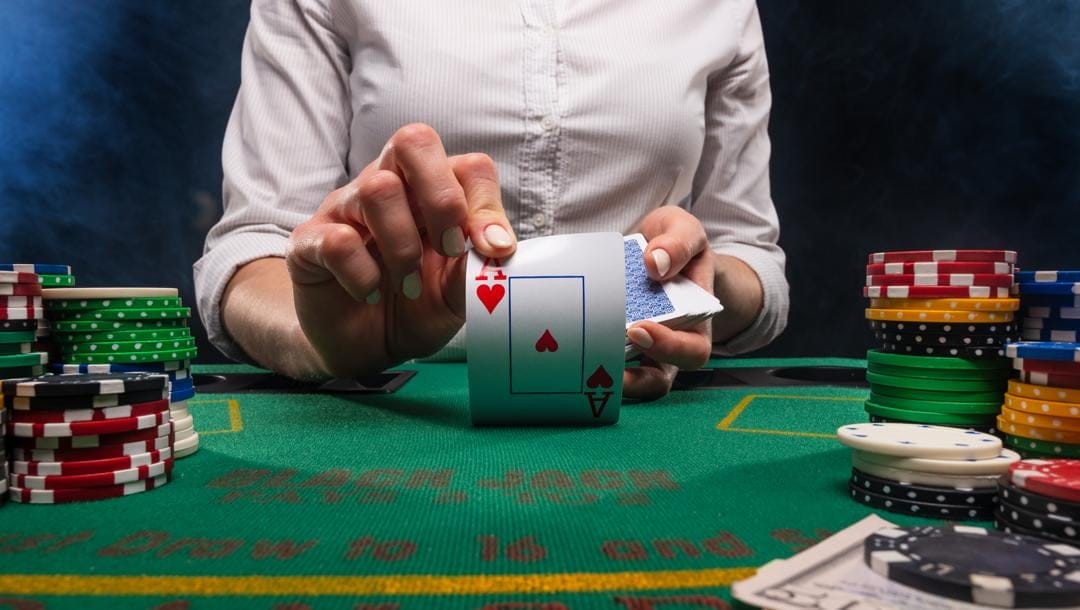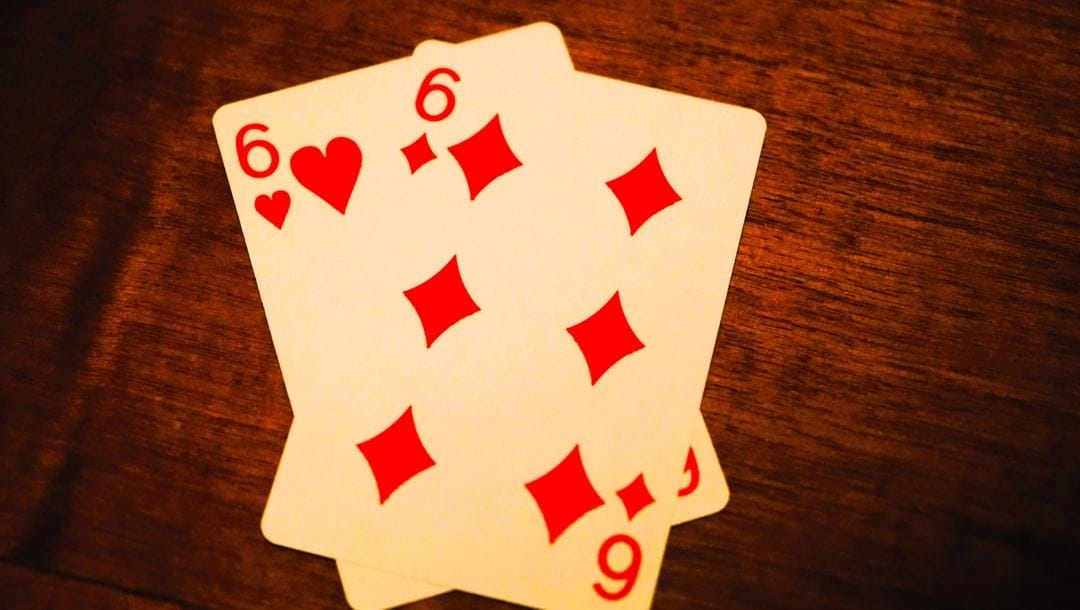While most blackjack players are familiar with the choice to hit or stand, there’s another move that is available in most games that can be a game-changer: the split. Whether you’re enjoying a digital version of blackjack or one of the many live dealer casino games at BetMGM, splitting can tremendously strengthen your position if done right.
When and how you split determines whether you’ve made the right move or took an unnecessary risk. In blackjack, the math can guide you in your evaluation, but because of the random nature of this particular table game, it’s possible to end up with a loss even if the math is on your side. With the right knowledge and smart plays, you can set yourself up to take advantage of luck being on your side when you’re splitting in blackjack.
What Is Splitting in Blackjack?
In most games, splitting is a simple move. Splitting in blackjack means that instead of playing a single hand in the game, you can split the cards across two hands when your first two cards have the same value, like a pair of eights in blackjack. Splitting pairs in blackjack is an option available in most games and is so common that many casinos use a hand signal for it.
In most versions of blackjack, your two hands are independent of each other, meaning that you can win your bet on one but not the other, win both wagers, or lose both bets. In many games, you have the option to further split these hands if you get another pair.
How Does Splitting Work in Blackjack
Typical blackjack games make it easy to split. Splitting in blackjack works by signaling your intention to the dealer and placing another stack of chips identical to your first wager on the table.
The standard hand signal for splitting is to form a triangle with your fingers behind your chips, then place the chips for your new bet. At that point, the dealer should acknowledge your split and give you more cards to complete your hands.
From there, the game proceeds as it would if you were still playing a single hand.
Why Should You Split in Blackjack?

Smart blackjack bankroll management involves evaluating the odds of a win when you split. After all, players’ moves are all about trying to shrink the blackjack house edge and splitting can be one way to do this. If you get the right combination of cards, the answer to the question of why split in blackjack is simply because the odds favor doing so.
However, not all situations are cut and dry, like whether or not to split a pair of sevens in blackjack. In instances like these, the math doesn’t make your play obvious.
The potential profit you might get from two hands that start with a seven compared to the additional risk you take by doubling your wager doesn’t always make sense. In these instances, you need to consider more than just the initial strength of your hands.
When is a Good Time to Split in Blackjack?
A simple rule of thumb regarding when to split in blackjack is that any time you improve your odds by splitting, you should split. The math dictates two must-split situations in traditional blackjack games.
The best example of what to split in blackjack is when you have a pair of aces in blackjack. There’s no reason not to split them if the blackjack rules allow you to do so.
Another situation in which splitting is nearly always recommended is when you’re holding a pair of eights. A hard 16 is a precarious position in most games.
In both cases, you’re taking what’s a mediocre blackjack hand at best and giving yourself great potential to collect some winnings. There are also instances in which conventional wisdom advises players to avoid splitting.
Pairs You Shouldn’t Split in Blackjack
Billions of blackjack hands played around the world over decades have produced some situations that simply don’t support splitting. In games with traditional rules, these circumstances include a pair of fours, fives, and 10s.
Many players see a pair of 10s and think of the potential upside of hitting blackjack on two hands instead of just one. After all, they’re already halfway there.
However, the probability of getting to 11 with subsequent cards in two separate hands isn’t in their favor. In fact, they have higher odds of busting on both hands.
With a pair of fours or fives, the same logic applies. The probability of receiving the specific mix of cards you need to get to a strong position with two hands starting with four or five is very unlikely.
Other pairs leave the decision more up for interpretation and this is when a blackjack strategy chart can help. You might have to adjust the chart for blackjack rule variations like whether the dealer can follow you in a split.
Can the Dealer Split in Blackjack?
Whether the dealer can split in blackjack is a classic example of a rule variation that can tremendously alter the math in a game. In most standard games, the dealer won’t have this option but players should never assume that’s the case.
In games that allow the dealer to split, players should be prepared for that situation. Reacting to a dealer split might look like buying blackjack insurance if the dealer splits on a pair of aces or surrendering depending on what cards you’re holding.
If the dealer cannot split, you can have more confidence that an opportunity to split might improve your standing. In either instance, the dealer’s cards should factor into your decision.
Splitting Based on the Dealer’s Up-Card

In most versions of blackjack, you’ll be able to see at least one of the dealer’s cards as you make your moves. Some blackjack variants will even allow you to know both of the dealer’s cards.
Following traditional rules, that card can dictate whether it’s to your advantage or not to split. Three examples show how specific combinations can put the math in your corner.
Dealer Showing Seven or Lower
If you have pairs of twos, threes, or sevens, and the dealer’s up-card is lower than eight but not an ace, it’s usually best to split. With these hands, the phrase “there’s nowhere to go but up” comes to mind.
These are some of the lowest-ranking blackjack hands, all of which have the potential to bust in one or two hits. So, if you split them, probability suggests that your hand is more likely to improve.
Player Holding Pair of Nines
If you’re holding a pair of nines and the dealer’s up-card is 2–6, an eight, or a nine. If they have an ace, seven, or 10 whether to split or not is a coin toss and standing is recommended. Standing on 18 is still a beatable hand, but unless you’re a master card counter and you know for sure which card will be dealt next, it’s never a good idea to hit on such a high value.
So, you just need to play the percentage game to see which odds you feel more comfortable with.
Player Holding Pair of Sixes

If the dealer’s up-card is 2–6 and you have a pair of sixes, splitting is usually a good move in terms of probability. If you split when the dealer has an up-card in this range, you could still get a 10, which would put you at an advantage over the dealer.
That may not happen and the dealer might still best both of your hands with sixes. However, you still made the smart play because a hand of 12 is a dangerous middle ground in many games.
Play Online Blackjack at BetMGM Casino
Experience is a great teacher for splitting in blackjack and helping you play blackjack with confidence. There are numerous opportunities to gain this experience at BetMGM as BetMGM has a large library of blackjack titles to choose from.
You can check out the vast menu as soon as you register for BetMGM. As you do so, you can also take advantage of the best casino rewards program available and BetMGM’s stellar promotions for blackjack fans.
Those promos and rewards are yours to enjoy regardless of whether your decisions to split pay off or not. One thing is certain: BetMGM players rarely want to split for another online casino.








